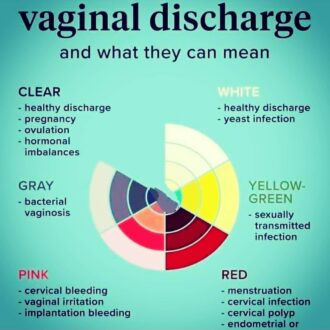 What is vaginal discharge?
What is vaginal discharge?
Vaginal discharge, as the name suggests, is a fluid that is produced inside the vagina and cervix. This fluid takes out the dead cells and bacteria from your body, hence, preventing the development of vaginal or yeast infections. The amount, color and odor of the discharge vary among women.
Vaginal discharge is a common phenomenon that is witnessed by most women at least once in their life. Often, women who have developed a vaginal infection or are suffering from vaginitis experience vaginal discharge. However, a woman may experience vaginal discharge due to other reasons which include vaginal cancer, during breastfeeding, and other such instances.
There are times when some doctors may diagnose a certain disease in women based on their vaginal discharge. This diagnosis, at times, may also stem from the family history of that particular woman. However, this diagnosis may not always be accurate. Hence, medications would have to be given by doing a thorough diagnosis when dealing with vaginal discharge.
What causes vaginal discharge?
Vaginal discharge is a normal bodily function that you do not need to worry about. This discharge helps keep your vaginal clean and free from infections. Normal vaginal discharge may occur when you are emotionally stressed, are sexually aroused, are breastfeeding, and other such instances.
However, then there is also an abnormal vaginal discharge which is of concern. The causes of abnormal vaginal discharge include:
- Bacterial Vaginosis
This is a common form of bacterial infection usually found in women who engage in oral sex or are sexually active with multiple partners. The discharge has a foul smell to it and is somewhat thick.
- Trichomoniasis
This infection generally develops in women via sexual contact or even sharing bathing suits or towels. The discharge of this particular kind has a yellowish green color to it. Women who are experiencing vaginal discharge due to trichomoniasis may also report inflammation, pain, and itching in their vagina.
- Yeast Infection
Stress1, diabetes, birth control pills, pregnancy, and excessive use of antibiotics can all cause the yeast levels in the vagina to increase. This increase then leads to the development of fungal or yeast infections. The discharge experienced by women who have a yeast infection is of a white color, somewhat resembling the color of cottage-cheese.
- Gonorrhea and Chlamydia
These are diseases that women encounter via sexual means. The vaginal discharge, in this case, has a cloudy consistency and is usually yellow and green in color.
- Pelvic Inflammatory Disease
PID is another sexually transmitted disease. This infection goes on and rests in the roots of a woman’s reproductive organs. The discharge experienced in this case has a heavy consistency and foul smell to it.
- Human Papillomavirus
HPV, otherwise known as cervical cancer, is another type of disease encountered via sexual means. The vaginal discharge, in this case, has a bloody and brown consistency to it. Also, the discharge is more liquid; like water.
Types of vaginal discharge
Following are some common types of vaginal discharge that are experienced by women. These include:
- Bloody and brown discharge
This generally indicates an irregular period cycle. However, at other times, this is also an indication of cervical cancer.
- Cloudy and yellow discharge
This type of discharge usually occurs because of gonorrhea which is a sexually transmitted disease.
- Frothy, yellow, and green discharge
This type of discharge is also a result of a sexually transmitted disease; trichomoniasis. This disease can also be developed if you share bathing suits or towels. This discharge not only has a sickly color to it but also smells foul.
- Pink discharge
This particular discharge is normal as you experience it after giving birth. During this type of discharge, your uterus is shedding its lining.
- Thick, white and cheese consistency discharge
This particular type of discharge is caused when a woman has developed a yeast infection. This fungal infection may also cause swelling, pain, and itching of the vagina.
- White, grey, yellow discharge
This particular discharge is usually experienced by women who are sexually active with multiple partners or who often engage in oral sex.
Signs and symptoms
Vaginal discharge can be categorized as normal discharge and abnormal vaginal discharge. There are no particular signs and symptoms specific to normal vaginal discharge. However, under the abnormal discharge, there are three main categories to be analyzed.
Signs and symptoms of vaginal discharge due to infections
- Swollen vulva
- You experience pain in your vulva
- Inflammation of the vagina
- Increased levels of itching of the vagina
- Experiencing an unnecessarily high degree of pain during sexual intercourse
- Experiencing a white and milky discharge
- Experiencing a cottage-cheese similar discharge
Signs and symptoms of vaginal discharge due to sexually transmitted diseases
- Experiencing a white or grey discharge
- Sometimes having a yellow and green discharge
- Burning sensation in the vagina
- Redness and swelling of the vagina
- Foul smell
- Apparent after your monthly cycle
- Watery discharge
Vaginal cancer symptoms
- Water-like discharge
- Constipation
- Pelvic pain
- Need to urinate often
- Pain during urinating
- Lump in the vagina
- Unexplained vaginal bleeding
Treatment
- For vaginal cancer discharge
For vaginal cancer, you should have regular check-ups with your doctor if you feel that you are developing some problem. You should discuss with your doctor and have yourself tested. Also, you can talk to your doctor about getting the HPV vaccine2. This is known to reduce the risk of you developing vaginal cancer.
Also, keep in mind that smoking elevates vaginal cancer. Hence, slowly limit and then completely quit smoking.
- For infections
The most common type of fungal infection is a yeast infection. For its treatment, you are generally given medicine to put in your vagina. Apart from this, your doctor may also put you on oral medication.
- For sexually transmitted diseases discharge
This problem is commonly treated via oral medicines, including antibiotics. Also, in some cases, even your partner may be subject to treatment if you are developing this problem due to them.
Conclusively, here are some tips that you can follow:
- Keep yourself clean
- Take care of your hygiene
- Go for regular check-ups
- Take your partner for check-ups
- Wear clean clothes
- Wear clean underwear
References:
- Cheyenne Women’s Clinic – Stress And Yeast Infections
- WebMD – Children’s Vaccines – Human Papillomavirus (HPV) Vaccine: What You Need to Know IMPORTANT NOTE: The above information is intended to increase awareness of health information and does not suggest treatment or diagnosis. This information is not a substitute for individual medical attention and should not be construed to indicate that use of the drug is safe, appropriate, or effective for you. See your health care professional for medical advice and treatment.
Can't Login into Your Account?
Call Us: 1-833-356-6337

We Accept Credit Cards, International Money Orders, Cash, Certified Checks and Bank Transfer
Canada Canadian Pharmacy dispenses all medications from licensed and regulated independent pharmacy partners internationally, including but not limited to Australia, Canada, New Zealand, India, Mauritius, Turkey, United States, Singapore and the United Kingdom. All Images on this site are registered trademarks of original manufacturers, international exporters, and property of their respective owners and are for reference only. Canada Pharmacy Online procures all products from licensed regulated international in order to provide you unbeatable lowest prices and prescription discounts for all your prescription medications, medications and Canadian Drugs at Canada Pharmacy Online.
CUSTOMER INFORMATION
TOP SELLERS
2005-2023 Rxdrugscanada.com


